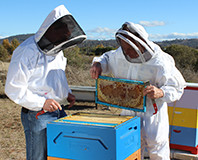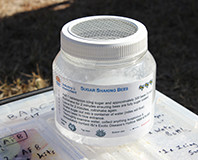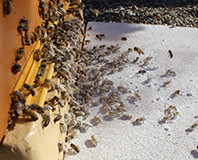Read the latest information on
Foot-and-mouth disease

Frank Derwent and Alan Wade inspecting a hive for pests and diseases.
Alan Wade was the first President of the Beekeeper’s Association of the ACT. He helped establish the club about 40 years ago, but the number of members has grown enormously in the last few years, because it’s become fashionable to keep bees.
Alan says that honey bee biosecurity is all about bee condition.
“You need to keep an eye on your bees: check that they are not affected by pesticides, that they have adequate nutrition. Check the bees if the weather becomes adverse to see that the brood hasn’t been killed by a cold snap or something like that.”
“We look at the bees and get them to tell us what’s going on. We make a note if they are collecting pollen and nectar. Then we open up the hive and look at the brood, and look at every frame systematically.”
One of the rules that relates to biosecurity at the Jerrabomberra Wetlands apiary run by the association is that they don’t bring any gear in.

Sugar shaking jar, which has the instructions for use, images of mites and the Exotic Plant Pest Hotline information included on the label.
“We only use hive tools, smokers and gloves that are located on site. And we make sure that every time we go out of the apiary, that if the hive tool has propolis, wax or honey on it, that all gets a hot scrub and wash, so that if there is anything in one hive that’s a bit suspicious you don’t use that gear on the next hive,” advised Alan.
Government managed sentinel hives are at ports to be close to where imports arrive in the country. Alan says that people like him, amateur beekeepers, especially those who have hives close to ports, are important too.
“We are running a sentinel program at the apiary, looking for varroa mite in particular, but also tropilaelaps mite. The association is trying to lead by example, monitoring for these things using what’s called the sugar shake method so we know we haven’t got them.”
Members of the association also look for serious brood diseases like American or European foulbrood.
“You put a match stick in and pull it out: it will rope out and smell sour. With American foul brood you need to kill the bees and send the frames off for radiation or burn the whole colony and start again.”
“We keep records of what we do. So if we find sacbrood or chalkbrood, which are quite common and could be in most hives, we record that. For sacbrood or chalkbrood, we can feed sugar syrup or requeen, which increases the number of young bees coming into the apiary, and seems to improve the vigour and hygienic behaviour and those things get carted out.”
“So it’s not just one thing. It’s a combination of nutrition, diseases status and having good bees going into winter is important for their survival.”
The association provides education and training, particularly for new members, and people who attend training courses get a manual on beekeeping (NSW).

Bees used in the sugar shake test can be returned to the hive if they do not have any mites.
“Topics include good practices, monitoring for disease, feeding bees, assembling gear properly, that sort of thing. We have people along at meetings to talk about biosecurity and good beekeeping management practices.”
The apiary keeps different types of hives, using different types of management systems.
“For example, there’s a new type of insulated hive. We are finding that the bees do much better in that. They are less stressed and less likely to become diseased.”
“Whatever the type of hive, we insist that the ACT code of practice be followed. Things like regular requeening, that sort of thing.”
“The idea is that we want people to do the best with what they’ve got: we want them to become not just bee owners, but beekeepers. The people who look after their bees are finding that if you look after the bees, they’ll look after you,” observed Alan.